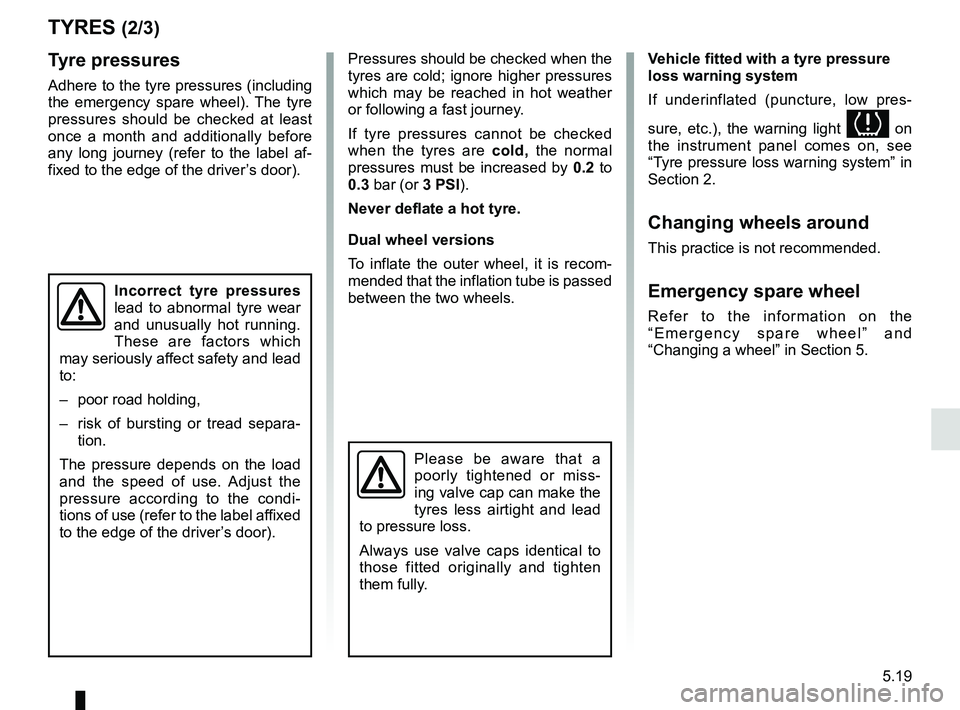2018 RENAULT MASTER spare wheel
[x] Cancel search: spare wheelPage 229 of 290

5.15
Tighten the nuts and lower the jack.
With the wheel on the ground, tighten
the bolts completely, following the order
of tightening below:
Wheel with 6 holes: start with screw A,
then D, B, E, C and finish with F.
A
B
CD
E
F
G
I
K
H
J
CHANGING A WHEEL: hydraulic jack (3/3)
Have the tightening and the pressure
of the spare wheel checked as soon as
possible.
Wheel with 5 holes: start with screw G,
then J, H, K and finish with I.
Page 231 of 290

5.17
CHANGING A WHEEL: jack (2/2)
If you have a puncture, re-
place the wheel as soon as
possible.
A tyre which has been
punctured should always be inspec-
ted (and repaired, where possible)
by a specialist.
With the wheel on the ground, tigh-
ten the bolts firmly, starting on side C,
then E, G, D and ending with F. Check
the tightness and the tyre pressure on
the emergency spare wheel as soon as
possible.
C
E
G
D
F
If bolts are supplied with the emergency
spare wheel, only use these bolts for
the emergency spare wheel. Tighten
the bolts, checking that the wheel is
correctly positioned on its hub and uns-
crew the jack.
Note: do not lubricate the wheel bolts.
Anti-theft bolt
If you use anti-theft bolts, fit these
nearest the valve (otherwise it may
not be possible to fit the wheel trim).
Position jack 4 horizontally. Jack head 3
must be positioned level with the rein-
forcement panel closest to the wheel in
question or the contact points 5;
start cranking the jack up by hand to
align the base plate (which should be
pushed slightly under the vehicle).
Turn the wheelbrace a few times using
the wheel spanner 2 until the wheel is
lifted off the ground. Remove the bolts
and take off the wheel;
fit the emergency spare wheel on the
central hub and turn it to locate the
mounting holes in the wheel and the
hub.
3
5
3
24
Page 233 of 290

5.19
TYRES (2/3)
Tyre pressures
Adhere to the tyre pressures (including
the emergency spare wheel). The tyre
pressures should be checked at least
once a month and additionally before
any long journey (refer to the label af-
fixed to the edge of the driver’s door).
Incorrect tyre pressures
lead to abnormal tyre wear
and unusually hot running.
These are factors which
may seriously affect safety and lead
to:
– poor road holding,
– risk of bursting or tread separa- tion.
The pressure depends on the load
and the speed of use. Adjust the
pressure according to the condi-
tions of use (refer to the label affixed
to the edge of the driver’s door).
Please be aware that a
poorly tightened or miss-
ing valve cap can make the
tyres less airtight and lead
to pressure loss.
Always use valve caps identical to
those fitted originally and tighten
them fully.
Pressures should be checked when the
tyres are cold; ignore higher pressures
which may be reached in hot weather
or following a fast journey.
If tyre pressures cannot be checked
when the tyres are cold, the normal
pressures must be increased by 0.2 to
0.3 bar (or 3 PSI).
Never deflate a hot tyre.
Dual wheel versions
To inflate the outer wheel, it is recom-
mended that the inflation tube is passed
between the two wheels. Vehicle fitted with a tyre pressure
loss warning system
If underinflated (puncture, low pres-
sure, etc.), the warning light
on
the instrument panel comes on, see
“Tyre pressure loss warning system” in
Section 2.
Changing wheels around
This practice is not recommended.
Emergency spare wheel
Refer to the information on the
“Emergency spare wheel” and
“Changing a wheel” in Section 5.
Page 284 of 290

7.2
ALPHABETICAL INDEX (2/4)
emergency active braking......................................2.16 → 2.23
emergency brake assist.........................................2.16 → 2.23
emergency braking ................................................2.16 → 2.23
emergency spare wheel ............................................. 5.2 – 5.3
engine technical specifications .................................................. 6.5
engine coolant ..................................................................... 4.9
engine oil ...................................................................4.4 → 4.7
engine oil level ..................................................1.83, 4.4 → 4.7
engine specifications ........................................................... 6.5
environment ............................................................\
........... 2.13
ESC: electronic stability control .............................2.16 → 2.23
external lights and signals ...................................1.96 → 1.100
external temperature ......................................................... 1.93
F
filter .................................................................\
................... 4.10
fitting a radio ...................................................................... 5.40
foot panel ........................................................................\
... 5.37
front passenger air bag deactivation .....................1.70 → 1.72
front seat adjustment ......................................................... 1.21
front seats ........................................................................\
.. 1.21
fuel advice on fuel economy ..................................... 2.8 → 2.11
consumption ...................................................... 2.8 → 2.11
filling .............................................................. 1.102 – 1.103
grade ..................................................................\
........ 1.102
fuel consumption ..................................................... 2.8 → 2.11
fuel filler cap ....................................................... 1.102 – 1.103
fuel grade........................................................................\
. 1.103
fuel level ........................................................................\
.... 1.83
fuel repriming ...................................................... 1.102 – 1.103
fuel tank .............................................................. 1.102 – 1.103
fuel tank capacity ............................................................. 1.102
fuses ..................................................................\
....5.28 → 5.32G
gear lever......................................................2.14, 2.45
→ 2.49
grab handle........................................................................\
3.18
grip control ........................................................................\
. 2.22
ground clearance ........................................................ 6.6 – 6.7
H
handbrake........................................................................\
.. 2.15
handsfree.................................................................... 1.8 – 1.9
hazard warning lights signal ............................................ 1.101
headrest........................................................................\
..... 1.20
heated seats ...................................................................... 1.21
heating and air conditioning system ........3.2 – 3.3, 3.7 → 3.13
heating system ......................................3.2 → 3.6, 3.13 – 3.14
Hill Start Assist.......................................................2.16 → 2.23
HSA: Hill Start Assistance ................................................ 2.23
hubcap tool ...................................................... 5.4, 5.11 – 5.12
I
idle speed ........................................................................\
.. 2.43
indicators .............................................................\
............ 1.101
indicators: direction indicators ..................................................... 1.101
instrument panel ..............................................1.78 → 1.83
instrument panel ....................................................1.78 → 1.85
interior lighting: changing bulbs ............................................................. 5.27
interior trim maintenance ..................................................... 4.17 – 4.18
J
jack ...................................................................\
................... 5.4
K
keys ...................................................................\
........1.2 → 1.6